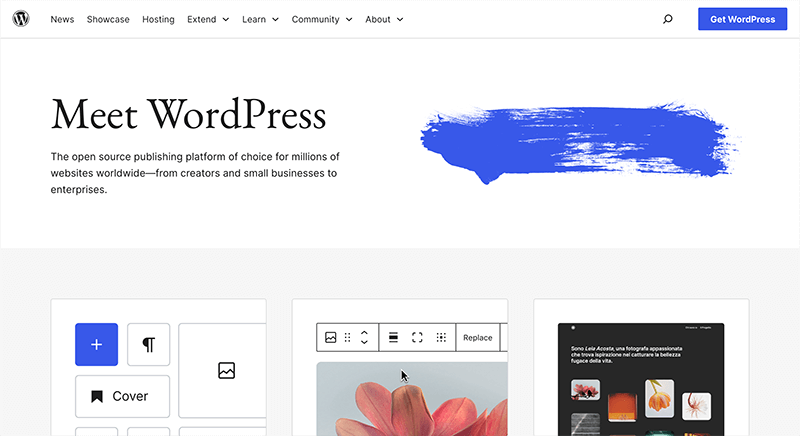Navigating the world of WordPress can be confusing, especially when it comes to understanding the WordPress.org vs WordPress.com difference. These two platforms may seem similar, but they’re actually quite different. Whether you’re new to blogging or an experienced website owner, knowing the distinctions between WordPress.com and WordPress.org is crucial.
A common question among users is: “WordPress.com vs WordPress.org – which is better?” To help answer this, we’ve put together a detailed comparison of the differences between WordPress.org vs WordPress.com. Whether you’re looking for a free platform or considering self-hosting, we’ll guide you through the key factors to consider when choosing the right WordPress solution for your needs.
WordPress.com vs WordPress.org Comparison
Before we get into the details of how WordPress.com and WordPress.org differ, here’s a simple comparison table to give you an overview.
| WordPress.com | WordPress.org | |
| Ease of Use | You just need to sign up and pick a plan. The WordPress dashboard provides a setup guide to assist you. | You need to get hosting and a domain. Although you get a similar WordPress dashboard, there’s no setup guide. |
| Flexibility and Customization | Themes and plugins are limited. You can add custom CSS, but you can’t access WordPress files. | Install any themes and plugins. You can customize WordPress files through your hosting account. |
| SEO | SEO tools require higher plans. | You can install any SEO plugin. |
| Price | Free plan available. Paid plans range from $4 to $25 per month. | Varies from under $100 to over $1,000 yearly, based on hosting and extensions. |
| Performance | Dependent on bundled hosting. Optimization plugins require higher plans. | Lets you choose some well-optimized hosting services. You can boost performance with plugins. |
| Security | Restricted to platform offerings. Backup creation available with higher plans. | Greater flexibility for implementing security measures. |
| eCommerce | To access store features, you need to unlock the eCommerce plan. | You can open your eCommerce site using a free plugin. |
Now that we have a basic understanding of the WordPress.org and WordPress.com difference, let’s delve into a more in-depth analysis of both versions of WordPress:
WordPress.org
WordPress.org is where you grab WordPress, the real deal everyone talks about. It’s perfect for bloggers and businesses who want full control over their sites. You can tweak it with custom themes, plugins, and tools to make your site look and work exactly how you want.

To get started with WordPress.org, you’ll need your own hosting plan and domain name. You’ll also have to download and install WordPress on your own. It’s called self-hosted WordPress because you manage the hosting yourself.
Now, let’s weigh the pros and cons of using self-hosted WordPress.org for your site.
WordPress.org Benefits
Opting for WordPress.org grants you full control over your website. You can customize it to your liking and make it truly your own.
Here are some reasons why WordPress.org is a top choice for website building:
- The WordPress software is free, open-source, and incredibly user-friendly. With over 43% of websites worldwide powered by WordPress, its popularity speaks for itself.
- You can customize your website’s design to your liking by choosing from a wide range of free or premium WordPress themes, or even create your own custom designs.
- You get access to a plethora of free, paid, and custom WordPress plugins/apps allowing you to enhance your website’s functionality effortlessly.
- You can transform your self-hosted WordPress site into an online store, enabling you to sell digital or physical products, accept payments, and manage shipping directly from your website.
- You can monetize your WordPress site by running your own ads without having to share revenue.
- You can utilize powerful tools like Google Analytics for comprehensive analytics and tracking.
- You can create membership sites, offering premium content, courses, forums, and more, to build a thriving online community around your website.
- You retain full ownership of your website and its data. No one can shut it down arbitrarily unless you’re engaged in illegal activities.
WordPress.org Downsides
While the self-hosted WordPress.org site offers numerous benefits, it’s important to consider a few potential drawbacks:
- You’ll need web hosting, where your website files reside. Initially, it can cost $3-$10/month. As your site grows, hosting costs may rise, but it will also generate more revenue to cover them.
- Installing WordPress is necessary, but most popular hosting companies offer 1-click installation options.
- You’re in charge of updates, but fortunately, updating your WordPress site is as simple as clicking a button (literally, just one click).
- Backups are your responsibility, but numerous WordPress backup plugins make setting up automatic backups a breeze.
The actual cost of a WordPress.org website varies depending on what you’re building (simple blog, portfolio site, eCommerce store, membership site, etc.). Other factors, like free vs premium templates and plugins, also play a role.
Even on a tight budget, you can build your website for as little as $46 per year.
WordPress.com
WordPress.com, led by WordPress co-founder Matt Mullenweg’s company, Automattic, is often confused with the popular WordPress.org. Offering a free platform, it’s perfect for beginners who want to create a simple website. Its easy-to-use interface allows you to focus on making great content without the hassle of technical stuff, so that you ca start blogging and customize your site right away.

Regarding the plans, you’ll find various options, including a free one, which means you don’t have to worry about setting up or hosting your site:
- Free: Limited features.
- Starter: $48 per year.
- Explorer: $96 per year.
- Creator: $300 per year.
- Entrepreneur: $540 per year, good for online stores with WooCommerce.
- Enterprise: Starts at $25,000 per year.
Now, let’s talk about the pros and cons of using WordPress.com.
WordPress.com Benefits
For hobby bloggers and those starting family blogs, the free WordPress.com platform offers a user-friendly option. Here are a few advantages of using WordPress.com:
- Initially, you get 3GB for free. If you need more space, there are paid plans available: Starter ($48/year) gives you 6GB, Explorer ($96/year) offers 13GB, and Creator ($300/year) comes with a generous 50GB.
- You benefit from automatic updates and backups, which alleviate the burden of maintenance, ensuring your site remains secure and up-to-date.
WordPress.com Downsides
Free WordPress.com comes with some limitations that differentiate it from WordPress.org. Here are a few downsides to consider when using WordPress.com:
- You can’t add custom themes on the free plan. Only a limited selection of free themes is available. But if you upgrade to the Explorer or Creator plan, you can pick premium themes and tweak them with custom CSS. Customizing options are limited in the free version.
- Plugin uploads are disabled; however, users on the free plan benefit from pre-activated Jetpack features. Those on the Creator plan can install compatible plugins from a curated selection for $300/year. The WordPress.com VIP program enables plugin installation, starting at $5000 per month.
- Ads are shown on all free websites, visible to users without generating revenue for you. To remove these ads from your site, upgrading to a paid WordPress.com plan is required, with options starting at $48 per year.
- Selling ads on your website is prohibited, significantly restricting your monetization options. However, if you operate a high-traffic site, you can apply for the WordAds advertising program, sharing revenue with WordPress.com. Explorer plan users and up can use WordAds right away.
- You’re limited to their stats and can’t add Google Analytics or other powerful trackers. Only Creator plan users can add Google Analytics.
- WordPress.com lacks eCommerce features or integrated payment gateways unless you upgrade to the Entrepreneur plan.
- You can’t create membership websites with WordPress.com.
- Free WordPress.com sites have a WordPress.com subdomain (e.g., https://example.wordpress.com). To get a custom domain like https://www.example.com, you’ll need a paid plan.
- Your site will display a powered by WordPress.com link, which can be removed with the Creator plan.
- They reserve the right to delete your site if they deem it violates their terms of service.
In essence, while WordPress.com offers an accessible entry point into the world of blogging and website ownership, unlocking its full potential may require investment in higher-tier plans or alternative hosting solutions.
WordPress.com vs WordPress.org – Which is Better?
Both WordPress.com and WordPress.org use WordPress, the well-known content management system. But, they have key differences. Knowing these will help you pick the right one for you.
There’s no clear winner between WordPress.com and WordPress.org. It depends on what you need, your budget, and how skilled you are at building websites.
If you’re a personal blogger who doesn’t want to make money from your site, go for free WordPress.com. It’s great for beginners who want a simple, free site.
But if you’re a business owner or a blogger looking to make money, choose self-hosted WordPress.org. It gives you more freedom and control over your site, including customization, SEO, security, and performance.
While WordPress.com’s Creator plan ($300/year per site) has advanced features, self-hosted WordPress only costs $46 per year and gives you more bang for your buck. For more details, read our guide on How to Make a WordPress website.
Conclusion
In our opinion, WordPress.org is the better choice. It’s used by professionals, small businesses, and big brands alike. With that being said, we trust this guide helped you in understanding the WordPress.org vs WordPress.com difference. Don’t hesitate to share it on social media or email using the buttons below.
